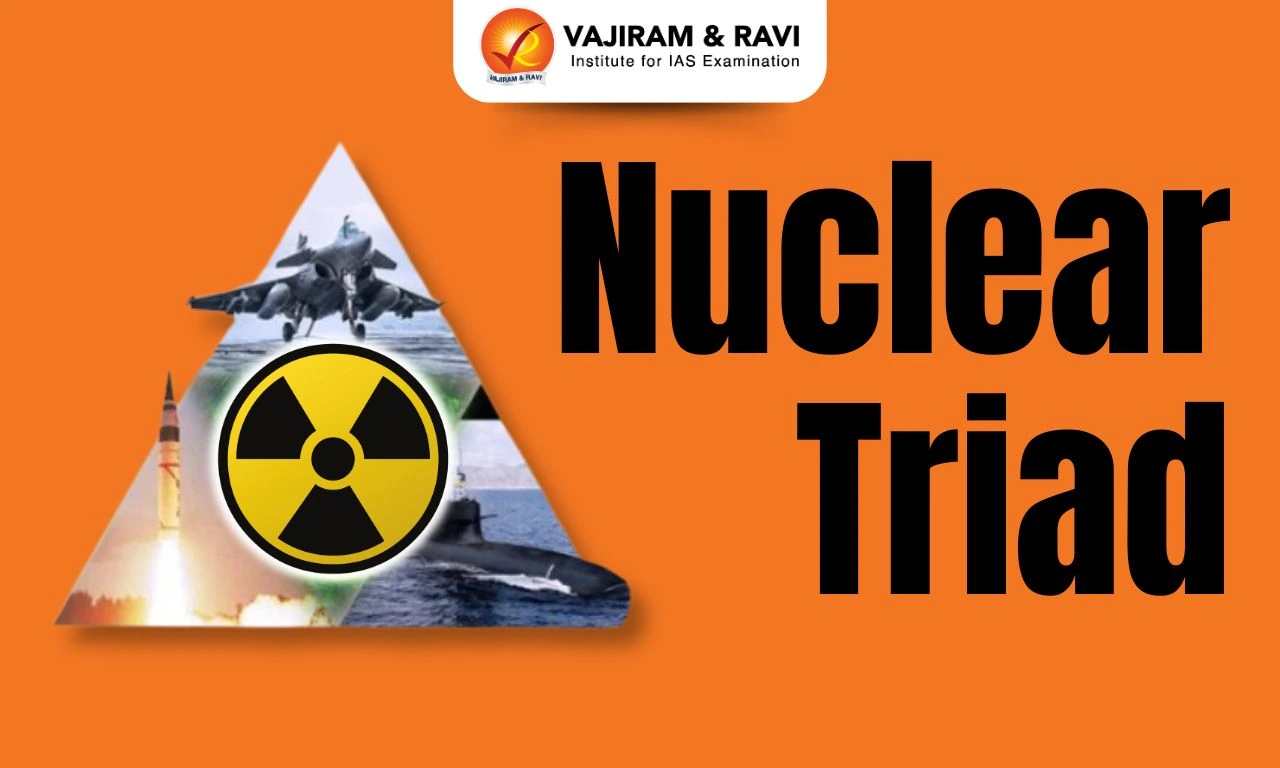The Nuclear Triad of India is a three-sided military-force structure consisting of ICBMs (land-based nuclear missiles), SSBNs (nuclear-missile-armed submarines), and Strategic Bombers (strategic aircraft with nuclear bombs and missiles). The theory underlying the triad is that spreading the country’s extensive nuclear arsenals across various weapons platforms and dimensions would provide a Credible Minimum Deterrence (CMD). In 2018, with the deployment of INS Arihant (an SSBN),a Strategic Strike Nuclear Submarine, India got its fully operational Nuclear Triad.
Components of India’s Nuclear Triad
India’s Nuclear Triad, as with other nations, comprises three components, each having the capability of a nuclear strike - Land, Air, and Naval (Sea).
Land-based Components
It mainly includes missiles that can be launched from land-based platforms such as ICBMs (Inter-continental Ballistic Missiles), SRBMs (Short Range Ballistic Missiles), etc. The ICBMsare quite responsive and lethal.
- ICBMs are deployed in hundreds of silos and can be launched and reach targets within minutes, creating a nearly insurmountable targeting problem for adversaries.
- For example, the Agni-V missile can go up to a range of 5500 Km with nuclear warheads.
- Other land-based missiles that can support the triad are Prithvi, Akash, Trishul, etc.
Sea-based Component
This component majorly includes the Ship Submersible Ballistic Nuclear Submarines (SSBNs).
- The SSBNs are considered survivable because a portion of the SSBN fleet is always on patrol, making it very difficult for potential adversaries to track all of them, contributing to their survivability.
- For example, INS Arihant with K-15 Sagarika missiles (700 Kms range) and K-4 (3500 Kms range) missiles.
- Also, the trials are going on with INS Arighat which has a possibility of getting inducted by 2024.
- It is more suitable to carry more K-4 missiles than INS Arihant.
- The SSBNs play a crucial role in the Second Strike against any nuclear attack complementing the Nuclear Doctrine as their location is unknown.
Air-based Component
It majorly includes the Bombers which are considered as flexible for attacking. The bomber aircraft are flexible and can resolve during a crisis and provide a variety of deployment and yield options when placed on alert.
- The aircraft that would work as bombers include the Sukhoi Su-30MKI, Mirage 2000H, SEPECAT Jaguar, and most importantly Rafale.
- The Land and air strike capabilities are controlled by Strategic Forces Command, a part of the Nuclear Command Authority.
- NCA was created in 2003 and is responsible for the management and administration of the country's tactical and strategic nuclear weapons stockpile.
- NCA is the authority responsible for command, control, and operational decisions regarding India's nuclear weapons programme.
- NCA was created in 2003 and is responsible for the management and administration of the country's tactical and strategic nuclear weapons stockpile.

Significance of India’s Nuclear Triad
India is among very few countries (United States, Russia, China, India, and Pakistan) which have achieved the capability of nuclear triad. The Nuclear Triad has its own significance in providing security to a nation.
- Capability of Second Strike: The Nuclear Triad helps the country to counter-attack a nation after being attacked by nuclear warheads.
- This triad ensures that even after being hit by a nuclear warhead, one can counter the attacking nation.
- Balance of Power: For India, this triad is very crucial, since it shares its borders with its nuclear-empowered adversaries such as Pakistan and China.
- Both countries have sophisticated arsenals and believe they have the assets to credibly harm India.
- Having a nuclear triad, India is now aiming to counterbalance China’s assertiveness in South Asia.
- Credible Minimum Deterrence: It is one of the objectives of India’s Nuclear Doctrine which is complemented by possessing a fully operational nuclear triad.
- It provides sufficient deterrence from any attacking nation by creating a fear of the consequences (Second strike).
- Massive Retaliation: As per the Nuclear Doctrine, India’s second strike would be massive and the Triad supplements it.
- Hence, the Triad provides resilience and feasibility to counter.
Limitations of India’s Nuclear Triad
The deterrence of a nuclear triad depends on the vehicles (platforms) and the capabilities of missiles. The Nuclear Triad of India, though complete, still faces a few shortcomings.
- Regarding sea-based components:
- There is a need for more than one SSBN (nuclear-powered ballistic missile submarine) to ensure continuous deployment at sea.
- The K-15 missiles’ utility is limited by its 750 km range, which means that to counter China, submarines need to be present in the South China Sea to make the K-15 effective.
- The INS Arihant has the capacity to carry a lesser number of long-range K-4 missiles (still in development).
- Regarding Strategic Bombers:
- The air component of the triad includes nuclear warheaded Strategic Bombers for which India depends on other countries like Russia (Sukhoi), France (Rafale), etc.
- This increases the import burden on the country as well. Thus, indigenisation of the platforms and missiles is the need of the hour.
- Regarding land-based components:
- India has ICBMs as part of the triad but these can be tracked by Ballistic Missile Defence technology in the early phase of flight.
- Other advanced technologies such as Fractional Orbital Bombardment Systems (FOBS), Hypersonic Glide Vehicles, Hypersonic Cruise Missiles, etc. need to be developed, and these are in the development stage in India.
Last updated on November, 2025
→ Check out the latest UPSC Syllabus 2026 here.
→ Join Vajiram & Ravi’s Interview Guidance Programme for expert help to crack your final UPSC stage.
→ UPSC Mains Result 2025 is now out.
→ UPSC Notification 2026 is scheduled to be released on January 14, 2026.
→ UPSC Calendar 2026 is released on 15th May, 2025.
→ The UPSC Vacancy 2025 were released 1129, out of which 979 were for UPSC CSE and remaining 150 are for UPSC IFoS.
→ UPSC Prelims 2026 will be conducted on 24th May, 2026 & UPSC Mains 2026 will be conducted on 21st August 2026.
→ The UPSC Selection Process is of 3 stages-Prelims, Mains and Interview.
→ UPSC Result 2024 is released with latest UPSC Marksheet 2024. Check Now!
→ UPSC Prelims Result 2025 is out now for the CSE held on 25 May 2025.
→ UPSC Toppers List 2024 is released now. Shakti Dubey is UPSC AIR 1 2024 Topper.
→ UPSC Prelims Question Paper 2025 and Unofficial Prelims Answer Key 2025 are available now.
→ UPSC Mains Question Paper 2025 is out for Essay, GS 1, 2, 3 & GS 4.
→ UPSC Mains Indian Language Question Paper 2025 is now out.
→ UPSC Mains Optional Question Paper 2025 is now out.
→ Also check Best IAS Coaching in Delhi
Tags: nuclear triad quest

















